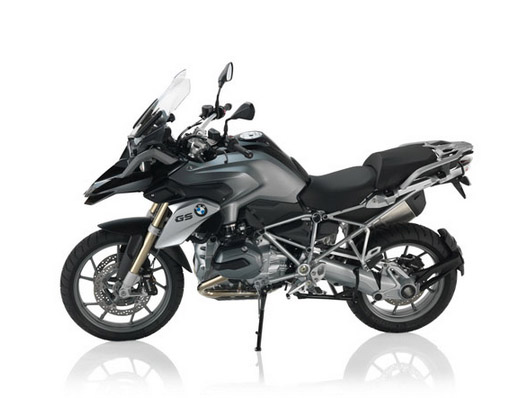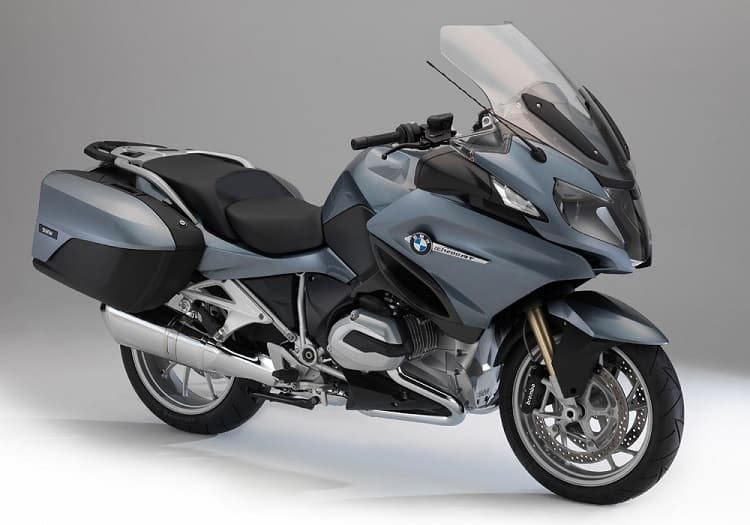My friend Bob rides BMWs. In the constantly evolving puzzle that is his garage, there’s always at least one BMW. For a little while last year, Bob and I went back and forth about trading my old Harley-Davidson Sportster for his old BMW R 1150 RT. We never made it work, and Bob sent his BMW down the road when he found a good used GS. But it got me thinking seriously about BMW motorcycles.
The BMW R 1200 RT got a complete makeover for 2014. The new model got off to a bumpy start when a suspension component caused a “DO NOT RIDE” notice to all owners and the recall/repair program that followed. After the high profile recalls in the automotive world in the past few years, this one was somewhat embarrassing for BMW, but the company made quick work of the recall and the RT was on its way to winning several “Best Sport Touring Bike” awards from the enthusiast magazines. It returns pretty much unchanged for the 2015 model year.
The RT is a sophisticated machine with a combination of mechanical, electronic and design features that all work together to deliver a deliciously comfortable, agile and engaging ride.
RT has the looks of an athlete, wearing a full fairing and bodywork like a tailored suit. Hard saddlebags are standard, and a clever, roomy top box is a smart option ($1,240 basic/$1,506 fully equipped). The bags all work with the ignition key, and can be locked remotely with the key fob or lock button on the dash with the optional ($400) central locking system. The bags all remove from the bike with a further twist of the key and have sturdy handles and rubber feet. I wouldn’t even bother with bag liners ($306) for most trips – I’d just unbolt the bags at my destination, and carry them into my hotel room.
I was most impressed by the narrow waist on the RT – it’s impossibly narrow, which makes it easy to get your feet on the ground comfortably from the 32.5” seat. If that’s not low enough, you can adjust the seat height to 31.7” without the use of tools. 17” cast aluminum wheels keep things level front and back. The 6.6-gallon gas tank should be good for a range of over 250 miles on the 604-lb (dry weight) motorcycle.
An electrically adjustable windshield responds to controls from a button on the left handlebar. It smartly retracts upon shutdown, and returns to its previous position when the bike is turned on again. At 6’2” with a long torso, I found the best wind protection with the windshield fully extended. I was still able to look over the screen (my preference), but noise and buffeting was greatly reduced.
Following a long BMW tradition, the front suspension is a Telelever. The Telelever replaces conventional telescopic forks with a system that uses both forks that attach to a steering head and a trailing link that attaches to the frame. BMW claims that the Telelever arrangement results in reduced dive during braking and greater feedback. Rear suspension is handled by a continuously variable, hydraulically adjustable Paralever single-sided swingarm. It’s difficult to evaluate the Telelever/Paralever setup in isolation, as it works with the new Dynamic ESA (Electronic Suspension Adjustment) system. Dynamic ESA settings are accessible via controls on the left handlebar and nested menus in the dash. Three ride mode settings are available: Rain, Road and Dynamic – pretty self-explanatory, and they affect suspension, ABS (Antilock Braking System), ASC (Automatic Stability Control) and engine control at the same time. Additionally, damper settings can be fine tuned to “Soft,” “Normal” or “Hard,” and load settings can be adjusted to match one rider, rider plus luggage or rider plus passenger – all without tools, just using the buttons and menus. I found that I played around with these menus at first, but as soon as I discovered the sweet spot (for me it was “Road,” “Normal” and solo rider), I left the settings alone and enjoyed a balanced, well-damped, smooth ride with great road feel.
The engine is at the heart of every motorcycle. The RT gets a new 1,170 cc twin-cylinder boxer engine that uses carefully targeted liquid cooling and air cooling. Liquid cooling was necessary to comply with emissions and noise regulations, and it’s seamlessly integrated into the bike. Claimed peak horsepower is 125 and arrives at 7,750 rpm; claimed peak torque is 92 lb-ft at 6,500 rpm. The engine is the same as the one in the highly popular dual sport BMW R 1200 GS, but with different gearing in its six-speed transmission. I loved this engine and transmission. Acceleration is always on tap, and the broad torque curve means that shifting can be adjusted to your style of riding that day. On a long highway ride, I would accelerate smoothly to cruising speed, getting into sixth gear as soon as possible. In heavy traffic, I’d hold gears a little longer, keeping the revs up and the bike ready for quick action. On a cruise through the canyons, I let the midrange do the work, staying away from the higher RPMs. The engine was happy no matter what I did, and so was I.
Electronics are both the strength and weakness of the RT. The left handlebar is a very crowded place, and for me, that spelled trouble. There’s just too much going on there. Two buttons for cruise control, a trigger for the brights, the menu button, the windshield adjustment, the turn signal control and the horn button all crowd onto the bar, and there’s a control wheel between the grip and the button housing. In cold weather gloves, I had difficulty operating individual controls, and I was constantly dialing the control wheel unintentionally, turning up the volume on the audio system. Further complicating operation is the fact that most of the audio controls live on a panel on the left side of the fairing, and it’s difficult to select the right button without looking down. The more I rode, the more familiar I got with the layout and operation, but I still found it distracting and more complex than necessary.
On the plus side, heated grips and a heated seat are standard, and work really well. The pillion gets a separate heating element and control, accessible to the passenger.
Navigation is an option ($799) on the RT, handled by a plug-in unit made for BMW by Garmin . The GPS unit lives under the lip of the fairing, but doesn’t lock in place for security – you have to remember to remove it when you park, or anybody can snatch it and walk away without using tools. That would be an expensive lunch stop.
I realize that I’ve gotten so caught up in the details of the RT – and there are a lot of them – that I haven’t really talked about the experience of riding the RT.
I loved riding this bike. I wasn’t sure I would, because I was concerned that the riding position might not be sustainable for me. My concerns were unfounded. I could ride this bike across the country tomorrow, and would if I had the chance. The bend in my knees and the footpeg position allowed me to move around on my seat, setting up for turns and moving forward and backward as conditions changed. The handlebars rose to meet me in exactly the right place for an upright, slightly forward posture that was easy to maintain and didn’t put any pressure on my wrists.
I rode the RT all over, from city streets to country lanes, and from packed rush hour freeways to open highways. The bike is maneuverable and easy to handle at low speeds, and fast and stable at highway speeds. My longest ride was a 200-mile jaunt from my home in North Hollywood up to visit family in Los Osos on California’s Central Coast, one of my frequent test ride routes. The RT excelled in all conditions. The bike is a frequent choice for use by the California Highway Patrol, which gave me the side benefit that alert drivers gave way in traffic when they saw me in their mirrors, thinking that I might be CHP. To protect and swerve, I say.
The BMW R 1200 RT is not a perfect bike. It’s on the pricey side, starting at $20,850 (including Premium Package), and BMW accessories can easily add thousands more to the bottom line. The competitors from Japan, the Kawasaki Concours 14 ABS ($15,499), Honda ST1300($18,230) and Yamaha FJR1300ES ($16,890), are all much less expensive. The Triumph Trophy SE ABS ($19,499) brings three cylinders to the fight for a slightly different flavor.
But the BMW R 1200 RT is a very, very impressive bike, and one of those bikes with enough strong points to encourage buyers to overlook its small weaknesses and eccentricities. I now understand my friend Bob and his garage a little better – and I envy his collection of BMW motorcycles a little bit more.

Best Touring Motorcycles Best Touring Motorbikes Devitt

BMW Introduces K16GT and K16GTL SixCylinder Motorcycles BMW

Fun vehicle Motos bmw Moto bmw 16 Motos
New SportTouring Motorcycles Offer Less Weight More Power for

BMW Touring Bikes gt BMW gt Aircrafts nishanttester MrOwl

Top 16 Mile Munching Sport Touring Motorcycles Autowise

The Best Touring Motorcycles to Buy in 16 The Magnificent 16

Top 16 Best Touring Motorcycles 16 spec and prices

Sport Touring Cycle BC Rentals amp Tours

16 Tough Touring Bikes We Love

The Five Best BMW Motorcycles of the 16s

Bmw touring bike

Top 16 Mile Munching Sport Touring Motorcycles Autowise
BMW K16GT Best SportTouring Bike Ten Best Motorcycles 16

BMW Motorrad's R 16 Classic Touring Motorcycle Channels Vintage

16 Best Touring Motorcycles for Long Rides Bike bmw Bmw
No comments:
Post a Comment